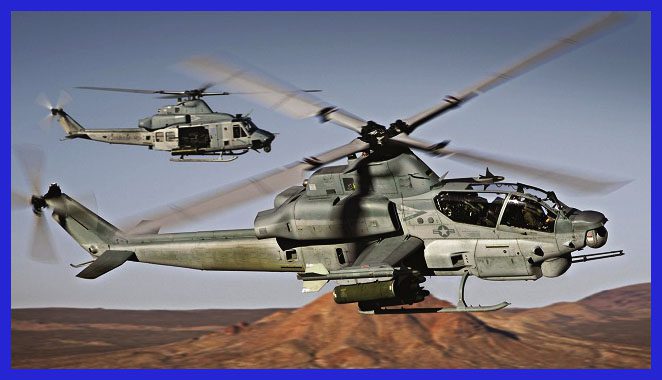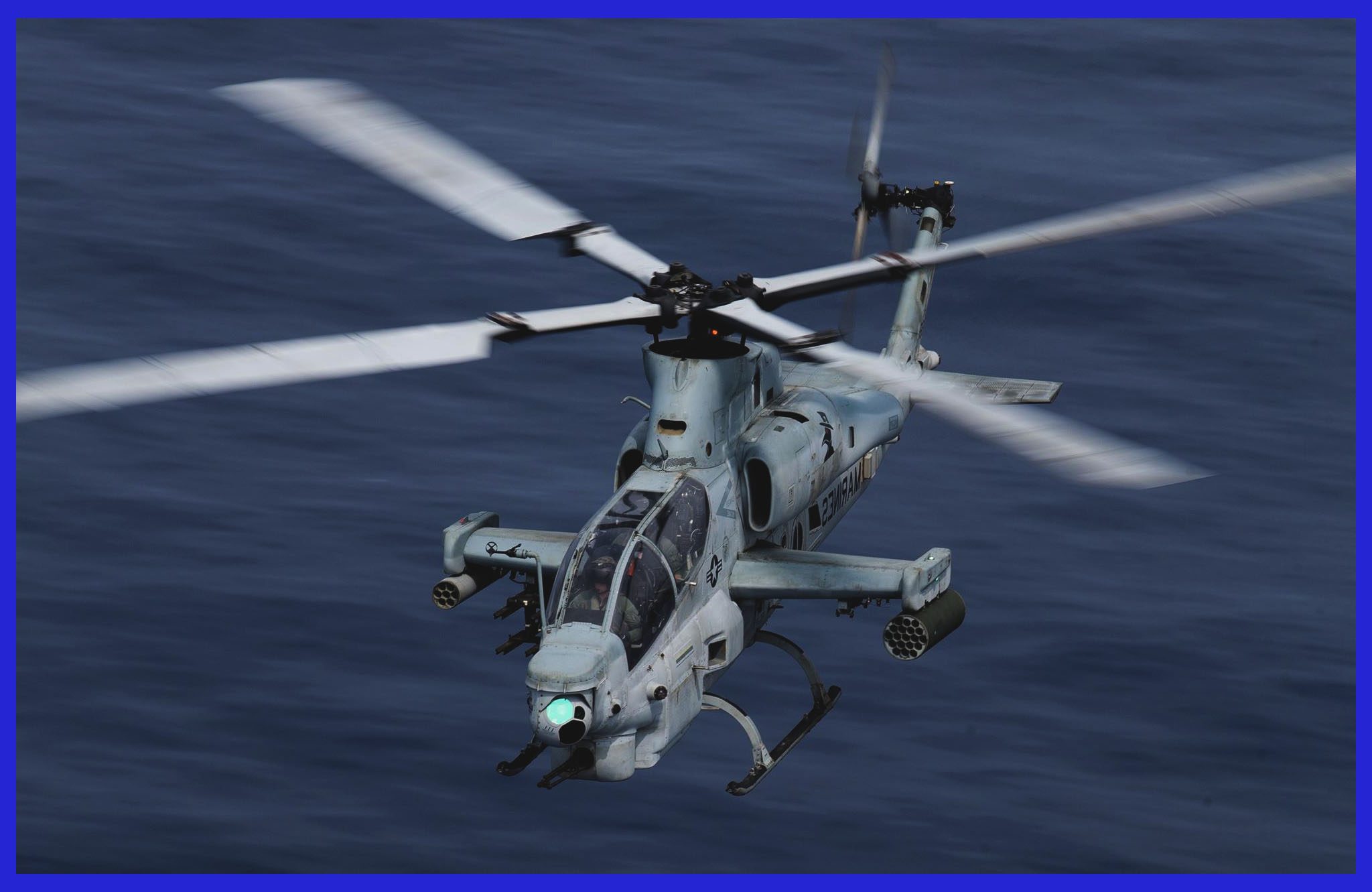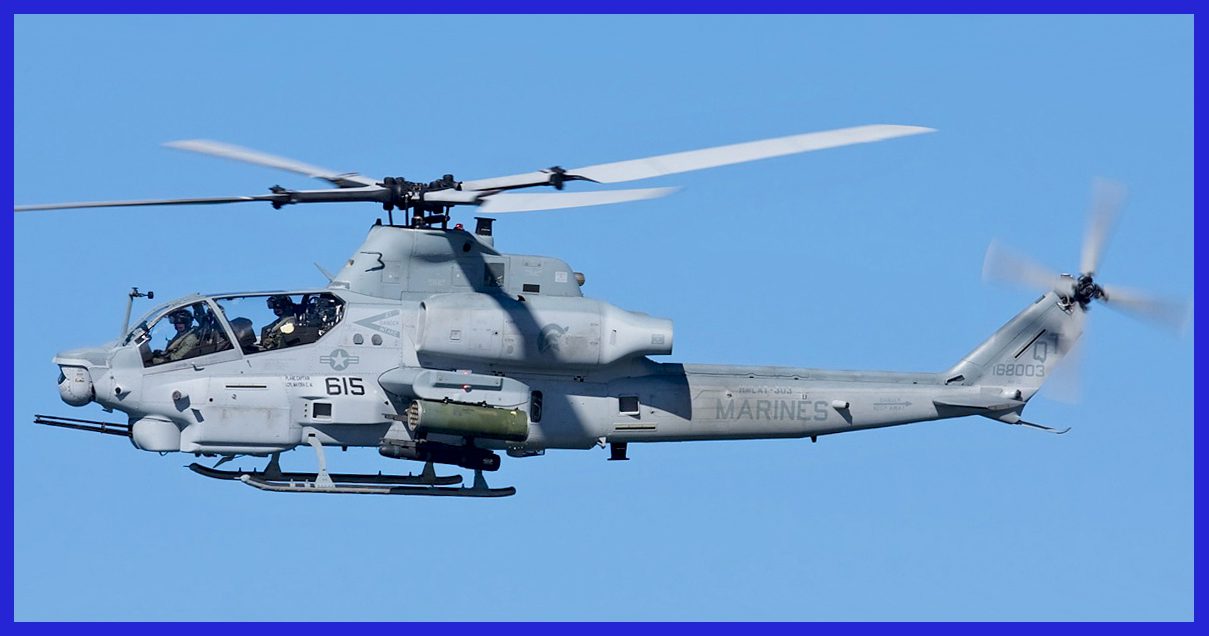In the domain of modern warfare technology and aerial excellence, only a select few machines manage to ignite the imagination and embody sheer power quite like the Viper. Unveiling the Bell AH-1Z Viper Military Helicopter showcases a truly remarkable rotorcraft, featuring an elegant and aerodynamic fuselage design along with a tandem seating configuration to accommodate both the pilot and co-pilot/gunner. This attack helicopter boasts a twin-engine setup, complete with a four-bladed main rotor system and a tail rotor, allowing for exceptional manoeuvrability and flight stability.
Bell Helicopter’s meticulous development and manufacturing have given rise to the AH-1Z Viper, the latest embodiment within the esteemed AH-1 Cobra family and now serving as the United States Marine Corps (USMC) primary attack helicopter.
To enhance its battlefield survivability, the AH-1Z Viper incorporates cutting-edge technologies. It features an advanced digital glass cockpit that integrates multi-function displays, providing the crew with critical information and reducing their workload.
On September 30, 2010, the United States Marine Corps (USMC) officially declared the AH-1Z as combat-ready, and it completely replaced its predecessor, the AH-1W Super Cobra, by October 2020. One notable feature of the AH-1Z Viper is its integrated avionics system, which includes the Target Sight System (TSS). The TSS comprises a long-range electro-optical sensor, laser designator, and rangefinder, providing the crew with the ability to effectively detect and engage targets during both day and night operations. This capability significantly enhances situational awareness and improves target acquisition capabilities. The AH-1Z Viper plays a vital role as a key element within the Aviation Combat Element (ACE) task force, supporting all phases of USMC expeditionary operations.

Since its introduction, the United States Marine Corps (USMC) has continuously pursued enhancements for the AH-1Z Viper. This advanced attack helicopter boasts an extensive array of armaments, including AGM-114 Hellfire anti-tank missiles, AIM-9 Sidewinder air-to-air missiles, twin Stinger launchers with one missile each, Minigun pods mounted beneath the wings, 70 mm rockets, and a formidable 20 mm three-barrel cannon located in its nose turret. Its very latest development is exemplified by the installation of the Link 16 datalink and equipping it with the AGM-179A Joint Air-to-Ground Missile (JAGM).
The integration of such a diverse selection of weaponry empowers the helicopter to engage with exceptional precision and firepower, effectively neutralizing both ground and air targets. Moreover, the AH-1Z Viper has captured the attention of numerous international customers, with Bahrain and the Czech Republic currently operating this formidable rotorcraft alongside the United States. Additionally, negotiations are currently underway with Slovakia for the acquisition of 12 AH-1Z Vipers, demonstrating the widespread interest and recognition of its capabilities on a global scale.
Furthermore, the AH-1Z Viper incorporates advanced technologies to improve survivability on the battlefield. It features an advanced digital glass cockpit with multi-function displays, providing the crew with vital information and reducing their workload. Additionally, the helmet-mounted display (HMD) enables the gunner to accurately engage targets using the chin-mounted three-barrel cannon and air-to-air missiles based on their line of sight. The helicopter also boasts enhanced ballistic tolerance, crashworthiness, and a suite of countermeasures to defend against threats such as infrared-guided missiles.
Overall, the Bell AH-1Z Viper is a highly capable attack helicopter designed for close air support, anti-armour operations, and armed reconnaissance missions. With its advanced avionics, powerful weapons, and robust design, it serves as a formidable asset for the USMC, ensuring battlefield dominance and the ability to effectively engage hostile targets.

The Concept Behind The Development Of The Bell AH-1Z Viper:
The concept behind the development of the Bell AH-1Z Viper was to create a highly capable and advanced attack helicopter that would serve as a formidable replacement for the ageing AH-1W Super Cobra in the United States Marine Corps (USMC) fleet. The AH-1Z Viper emerged as part of the H-1 upgrade program, which aimed to modernize the existing fleet of AH-1 Cobra helicopters. The roots of the AH-1Z can be traced back to the experimental Bell 249 of 1979, which essentially represented an upgraded AH-1S, equipped with the four-blade main rotor system derived from the Bell 412 utility helicopter.
The Bell 249 served as a demonstrator for Bell’s Cobra II concept, showcasing various new and redesigned combat systems, including the Hellfire missile and an advanced targeting system. It was also intended to be powered by improved engines. In 1993, Bell entered an AH-1W-based variant named the CobraVenom for the UK’s new attack helicopter program. This derivative featured a modern digital cockpit and the capacity to carry wire-guided missiles, such as the Hellfire and Brimstone. The CobraVenom design was further refined two years later, notably with the adoption of a four-blade rotor system.
In 1996, alongside the UK’s helicopter program, the United States Marine Corps (USMC) initiated the H-1 upgrade program. They signed a contract with Bell to upgrade 180 AH-1Ws into AH-1Zs. The objective of the H-1 program was to create a fleet of completely modernized attack and utility helicopters with significant design commonality, aimed at reducing operating costs. From the beginning, the new design aimed to incorporate shared components such as a common tail boom, engines, rotor system, drivetrain, avionics architecture, software, controls, and displays, with over 84% of the components being identical.
The program’s early phases primarily focused on research and development, which consistently advanced from 1996 to 2003. The previous two-blade semi-rigid, teetering rotor system was upgraded to a four-blade, hingeless, and bearingless rotor system. This upgrade improved several flight characteristics, including increased payload capacity, expanded payload envelope, higher maximum speed, improved vertical rate of ascent, and reduced levels of rotor vibration.
The highly anticipated AH-1Z, as envisioned by the USMC, took to the skies on December 8, 2000, and 2002, embarking on the thrilling flight test phase of the program. After a series of triumphant trials, low-rate initial production commenced in October 2003. Recognizing its immense potential, the Navy fervently requested an additional 46 airframes for the Marine Corps in September 2008, propelling the total number of orders to an impressive 226. Seizing the moment, the Marine Corps swiftly placed an order for 189 AH-1Zs in 2010, with a remarkable 58 of them being brand-new airframes. Deliveries, an ongoing spectacle of power, will continue unabated until 2022. However, the AH-1Z Viper cost remains undisclosed to the public.
In a defining moment that reverberated across the industry, Bell proudly delivered the 189th AH-1Z to the U.S. Marine Corps in November 2022, effectively concluding the monumental Viper program. This momentous occasion in 2018 marked the culmination of the H-1 series rotorcraft deliveries for the U.S. military, an enduring legacy that began in 1959 and has forever shaped the landscape of aviation.

An Analysis of the Bell AH-1Z Viper’s Design:
The Bell AH-1Z Viper is a modern attack helicopter that serves as the primary attack helicopter for the United States Marine Corps (USMC). It is an upgraded version of the AH-1W Super Cobra and incorporates various design improvements and advanced technologies. Here is an analysis of the AH-1Z Viper’s design:
Fuselage and Structure: The AH-1Z Viper boasts a streamlined and aerodynamically optimized fuselage, constructed using a combination of lightweight composite materials and advanced structural design. These features not only enhance its durability but also contribute to weight reduction. The helicopter’s structure is specifically engineered to withstand the rigours of combat operations while providing the utmost crew protection.
Extensive redesigning of the airframe ensures maximum crashworthiness, incorporating various measures such as energy-absorbing landing gear, fuel vapour inerting systems, self-sealing fuel tanks, energy-attenuating crashworthy seating, and a mass retention design approach applied to numerous major components. Active systems, including countermeasure dispensers, radar warnings, incoming/on-way missile warnings, on-fuselage laser spot warning systems, and the Hover Infrared Suppression System (HIRSS), serve to safeguard the engine exhausts.
Cockpit and Crew Seating: The AH-1Z Viper’s cockpit is meticulously designed for a two-person crew: a pilot and a co-pilot/gunner. Seated in tandem, with the gunner at the front and the pilot positioned higher and behind, this configuration ensures enhanced visibility, particularly for the gunner-engaging targets. The cockpit enables seamless operation for both crewmembers, with virtually identical controls and a Hands-on Collective and Stick (HOCAS) side-stick architecture. The pilot typically handles firing the wing stores and can engage the turret when it is in its stowed position.
In emergencies, the co-pilot/gunner can assume control and engage the wing stores. Equipped with the Thales “Top Owl” helmet-mounted sight and display system, both crew members benefit from a 24-hour day/night capability, a binocular display with a 40° field of view, and forward-looking infrared (FLIR) or video imagery. The helicopter’s design allows for the seamless integration of future upgrades. The Lockheed Martin target sight system (TSS) on the AH-1Z incorporates a third-generation FLIR sensor, providing target sighting and identification in various conditions.
It can identify and laser-designate targets at maximum weapon range, significantly enhancing platform survivability and lethality. The TSS, a passive sensor, offers different view modes, tracks target with FLIR or TV and feature a highly stabilized turret with colour and mid-wave infrared sensors, a laser designator, a laser range finder, and advanced image processing for sharper imagery.
Integrated Avionics and Sensors: The AH-1Z Viper incorporates advanced avionics and sensor systems that significantly enhance its situational awareness and combat capabilities. It features a glass cockpit with multi-function displays (MFDs) that provide critical flight and mission information to the crew. The helicopter is equipped with a target acquisition and designation system, night vision capabilities, and a helmet-mounted display system for targeting and weapons control.
Weapons and Weapon Systems: The Viper is equipped with an array of offensive weapons, featuring a 20mm three-barrel Gatling cannon mounted under the nose. It has stub-wing pylons capable of carrying diverse guided and unguided rockets, air-to-air missiles, and air-to-surface missiles. Additionally, the wingtip station can accommodate missiles such as the AIM-9 Sidewinder. Each stub wing possesses two additional stations for 70mm Hydra 70 rocket pods or AGM-114 Hellfire quad missile launchers. The wingtip station can also accommodate the Longbow fire control radar.
These stations can also be used for various mission equipment, including 77 and 100-gallon external auxiliary fuel tanks, nighttime illumination flares, and various types of practice munitions. Positioned beneath the AH-1Z’s nose is an A49E-7 turret housing a 20mm M197 three-barreled rotary cannon, which boasts higher muzzle velocity and a flatter trajectory compared to its predecessors. The helicopter’s weapon systems are seamlessly integrated with its avionics, enabling accurate and precise engagement of targets, day or night, regardless of weather conditions.
Performance and Powerplant: The AH-1Z Viper is propelled by twin General Electric T700-GE-401C turboshaft engines, delivering enhanced power and performance compared to its predecessor. It achieves a top speed of approximately 200 knots (230 mph) and boasts a range of about 370 nautical miles. The upgraded engines contribute to the helicopter’s improved agility, manoeuvrability, and high-speed capabilities. The rotor blades are constructed using composites, providing increased ballistic survivability. Additionally, the rotor is equipped with a semi-automatic folding system, enabling more efficient storage of the AH-1Z aboard amphibious assault ships and other transportation means.
Extensive efforts have been made to maximize maintainability and minimize maintenance requirements. Compared to the SuperCobra, numerous maintenance tasks have been eliminated, interactive electronic technical manuals have been created, reduced spare storage is necessary, and accessibility has been enhanced. Furthermore, the presence of various fault detection sensors facilitates condition-based maintenance.
Defensive Systems: To enhance survivability, the AH-1Z Viper incorporates a range of defensive systems. It is equipped with advanced electronic warfare and countermeasures systems, encompassing radar warning, incoming/on-way missile warning receivers, laser warning systems, and chaff/flare dispensers. Additionally, it features on-fuselage laser spot warning systems and the Hover Infrared Suppression System (HIRSS) to safeguard the engine exhausts. These comprehensive systems aid in the detection and mitigation of threats, including radar-guided missiles and hostile fire, across various weather conditions.
Maintenance and Logistics: Viper’s design also places emphasis on ease of maintenance and logistics support. It incorporates built-in diagnostic and health monitoring systems, enabling proactive maintenance and minimizing downtime. The helicopter’s modular construction facilitates component replacement and system upgrades, ensuring efficient maintenance and reducing lifecycle costs.

Technical Specifications Of The Bell AH-1Z Viper:
- Crew: 2 ( pilot & weapon system officer )
- Length: 58 ft 3 in ( 17.76 m )
- Height: 14 ft 4 in ( 4.38 m )
- Wingspan: Estimated around 17 feet ( 5.18 m )
- Empty Weight: 5,579 kg ( 12,300 lb )
- Gross Weight: 8,391 kg ( 18,499 lb )
- Power plant: 2 × General Electric T700-GE-401C turboshaft, 1,800 hp ( 1,300 kW ) each
- Main rotor diameter: 48 ft ( 14.63 m )
- Main rotor area: 1,808 sq ft ( 167.0 m2 ) 4-bladed both main and tail rotors
- Maximum Speed: 411 km/h ( 255 m/ph )
- Average Cruise speed: 300 km/h ( 186 m/ph )
- Ferry Range: 690 km ( 429 mi ) with 2 external fuel tanks
- Combat range: 232 km ( 144 mi ) with an estimated 2,500 lb ( 1,100 kg ) payload
- Service ceiling: Estimated 20,000 ft ( 6,096 m ) or more
- Rate of climb: 2,790 ft/min ( 14.17 m/s )
- g limits: Estimated around +3 / -0.5
- AH-1Z Viper Weapons: one 20mm ( 0.787 in ) M197 three-barreled rotary cannon in the A/A49E-7 turret, with an ammunition capacity of 750 rounds. It possesses a total of six hardpoints: two pylons under each stub wing to mount bombs, rockets, ASM missiles, and gun pods, and one mounted on each wing tip station (a total of two) for launching AAMs. The helicopter has a maximum carrying capacity of 2,615 kg (5,764 lb) and provisions to carry various combinations, including up to 16 AGM-114 Hellfire missiles (ASM), or AGM-179A Joint Air-to-Ground Missile (JAGM) missiles, along with two AIM-9 Sidewinder air-to-air missiles (AAM). Additionally, it can carry 28 Advanced Precision Kill Weapon Systems (APKWS) guided rockets and 76 Mk-66 2.75-inch unguided rockets.

Furthermore, seize the exclusive opportunity to acquire these exquisite large-scale 1/72 premium die-cast models of the formidable Bell AH-1 SuperCobra. These remarkable military rotorcraft, available now on AirModels, embody unparalleled craftsmanship and attention to detail. Don’t hesitate to click here and secure these exceptional models before our limited stock runs out.
In conclusion, the Bell AH-1Z Viper represents a significant leap forward in attack helicopter design. With its streamlined fuselage, advanced avionics, versatile weapons systems, and improved performance, it stands as a formidable weapon in the arsenal of the United States Marine Corps. The Viper’s design emphasizes enhanced situational awareness, precise targeting capabilities, and survivability, making it a highly effective platform for conducting combat operations. It’s modular construction and maintenance-friendly features contribute to efficient upkeep and reduced lifecycle costs. The AH-1Z Viper is a testament to the continuous advancements in helicopter technology, showcasing the capability to adapt and excel in modern warfare scenarios.
Important Announcement for Our Valued Readers!
After an article is published, it is possible that updates or changes may have occurred beyond the time of publication. Therefore, it is important to be aware that certain information in the article might be outdated. To ensure the most accurate analysis, it is highly recommended to verify the content with the latest sources available.
However, we are dedicated to delivering outstanding articles on military products and global updates. Maintaining quality and smooth operation requires resources. Your support sustains our efforts in providing insightful content. By purchasing high-quality products through our affiliated links, you help us keep our platform alive and acquire top-notch items. Your unwavering support is invaluable and inspires us to strive further.
We welcome your suggestions and requests for more information, as we value feedback from our readers. If there’s specific defence material or equipment not covered on our site, please share your request in the comments. We’ll strive to research and provide the required information. We sincerely thank you for your unwavering interest in our website, and we eagerly anticipate hearing from you! Enjoy your reading experience!
